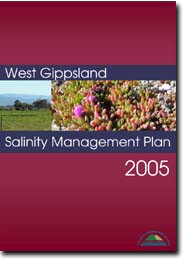West Gippsland Salinity Management Plan
To view the information PDF requires the use of a PDF reader. This can be installed for free from the Adobe website (external link).
The West Gippsland Salinity Management Plan - 2005 will address salinity in the West Gippsland region over the next 5 years. The plan details a package of management actions to reduce and prevent the effect of salinity on the region’s assets. The plan also details a time frame for adoption, cost sharing arrangements and roles and responsibilities for implementation. The plan is an initiative of the West Gippsland Catchment Management Authority as part of its regional natural resource management program. This plan builds on and updates the existing Lake Wellington Catchment Salinity Management Plan (1993) and the draft South Gippsland Salinity Strategy (2000). The West Gippsland Salinity Management Plan was written by Sinclair Knight Merz on behalf of the West Gippsland CMA.



